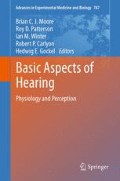Abstract
Compared to humans, Mongolian gerbils (Meriones unguiculatus) are much more sensitive at detecting mistuning of frequency components of a harmonic complex (Klinge and Klump. J Acoust Soc Am 128:280–290, 2010). One processing mechanism suggested to result in the high sensitivity involves evaluating the phase shift that gradually develops between the mistuned and the remaining components in the same or separate auditory filters. To investigate if this processing mechanism may explain the observed sensitivity, we determined the gerbils’ thresholds to detect a constant phase shift in a component of a harmonic complex that is introduced without a frequency shift. The gerbils’ detection thresholds for constant phase shifts were considerably lower for a high-frequency component (6,400 Hz) than for a low-frequency component (400 Hz) of a 200-Hz harmonic complex and increased with decreasing stimulus duration. Compared to the phase shifts calculated from the mistuning detection thresholds, the detection thresholds for constant phase shifts were similar to those for gradual phase shifts for the low-frequency harmonic but considerably lower for the high-frequency harmonic. A simulation of the processing of harmonic complexes by the gerbil’s peripheral auditory filters when components are phase shifted shows waveform changes comparable to those assessed for mistuning detection Klinge and Klump (J Acoust Soc Am 128:280–290, 2010) and provides evidence that detection of the gradual phase shifts may underlie mistuning detection.
Access this chapter
Tax calculation will be finalised at checkout
Purchases are for personal use only
References
de Cheveigné A (2005) Pitch perception models. In: Plack CJ, Oxenham AJ, Fay RR, Popper AN (eds) Pitch: neural coding and perception. Springer, New York, pp 169–233
Dooling RJ, Leek MR, Gleich O, Dent ML (2002) Auditory temporal resolution in birds: discrimination of harmonic complexes. J Acoust Soc Am 112:748–758
Goldstein JL (1967) Auditory spectral filtering and monaural phase perception. J Acoust Soc Am 41:458–479
Klinge A, Klump GM (2009) Frequency difference limens of pure tones and harmonics within complex stimuli in Mongolian gerbils and humans. J Acoust Soc Am 125:304–314
Klinge A, Klump GM (2010) Mistuning detection and onset asynchrony in harmonic complexes in Mongolian gerbils. J Acoust Soc Am 128:280–290
Licklider JCR (1957) Effects of changes in the phase pattern upon the sound of a 16-harmonic tone. J Acoust Soc Am 29:780
Lohr B, Dooling RJ (1998) Detection of changes in timbre and harmonicity in complex sounds by zebra finches (Taeniopygia guttata) and budgerigars (Melopsittacus undulatus). J Comp Psychol 112:36–47
Mathes RC, Miller RL (1947) Phase effects in monaural perception. J Acoust Soc Am 19:780–797
Moore BCJ (2002) Interference effects and phase sensitivity in hearing. Philos Trans R Soc Lond A 360:833–858
Moore BCJ, Glasberg BR (1989) Difference limens for phase in normal and hearing-impaired subjects. J Acoust Soc Am 84:1351–1365
Moore BCJ, Peters RW, Glasberg BR (1985) Thresholds for the detection of inharmonicity in complex tones. J Acoust Soc Am 77:1861–1867
Moore BCJ, Glasberg BR, Peters RW (1986) Thresholds for hearing mistuned partials as separate tones in harmonic complexes. J Acoust Soc Am 80:479–483
Nelson DA (1994) Level-dependent critical bandwidth for phase discrimination. J Acoust Soc Am 95:1514–1524
Palmer AR, Russell IJ (1986) Phase-locking in the cochlear nerve of the guinea pig and its relation to the receptor potential of inner hair-cells. Hear Res 24:1–15
Patterson RD (1987) A pulse ribbon model of monaural phase perception. J Acoust Soc Am 82:1560–1586
Plomp R, Steeneken HJM (1969) Effect of phase on the timbre of complex tones. J Acoust Soc Am 46:409–421
Pressnitzer D, Winter IM, Patterson RD (2000) The responses of single units in the ventral cochlear nucleus of the guinea pig to damped and ramped sinusoids. Hear Res 149:155–166
Author information
Authors and Affiliations
Corresponding author
Editor information
Editors and Affiliations
Rights and permissions
Copyright information
© 2013 Springer Science+Business Media New York
About this paper
Cite this paper
Klinge-Strahl, A., Parnitzke, T., Beutelmann, R., Klump, G.M. (2013). Phase Discrimination Ability in Mongolian Gerbils Provides Evidence for Possible Processing Mechanism of Mistuning Detection. In: Moore, B., Patterson, R., Winter, I., Carlyon, R., Gockel, H. (eds) Basic Aspects of Hearing. Advances in Experimental Medicine and Biology, vol 787. Springer, New York, NY. https://doi.org/10.1007/978-1-4614-1590-9_44
Download citation
DOI: https://doi.org/10.1007/978-1-4614-1590-9_44
Published:
Publisher Name: Springer, New York, NY
Print ISBN: 978-1-4614-1589-3
Online ISBN: 978-1-4614-1590-9
eBook Packages: Biomedical and Life SciencesBiomedical and Life Sciences (R0)

